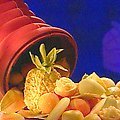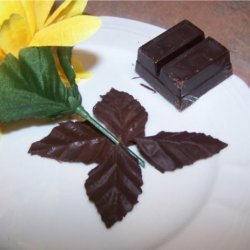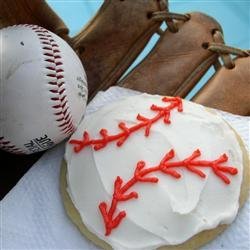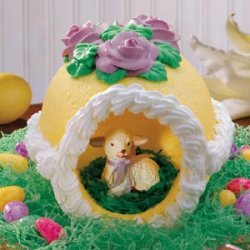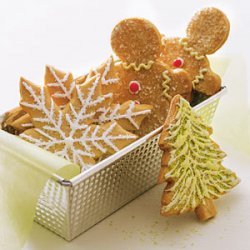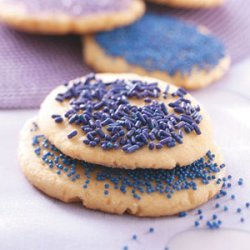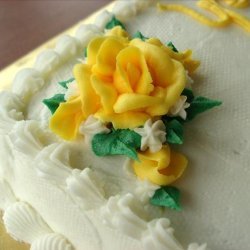Ingredients:
- powdered food colors
- rubber stamps , a design of your choice, available at craft stores
Directions:
- Use a sheet of textured acetate approximately 11 by 14 inches, purchased from a home improvement center or an art supply store. Place it on a flat work surface in front of you. Pour some tempered white chocolate onto the plastic and spread with an offset spatula to create a layer that is about 1/8-inch thick. You can gently shake the plastic to help the chocolate become smooth. Use a sharp chef's knife to cut the chocolate when it begins to set but before it hardens into 1-inch squares. When the chocolate has set completely, arrange the squares so you can easily print on them with the rubber stamps.
- To print with the rubber stamps: Place a clean dishtowel on a baking sheet and set aside. Place about 1/4 teaspoon powdered food color in small glass bowl. Pour some of the melted cocoa butter into each bowl of color. Mix with a paint brush, you can add more powdered food color if you want a stronger color. You can do as many colors as you want by using separate bowls and dividing the melted cocoa butter between the different colors. Paint some of the colored melted cocoa butter onto the towel. The towel will serve as a blotter. Press the rubber stamp into the color and then delicately onto the chocolate square. The design of the rubber stamp will transfer onto the chocolate. If the colored cocoa butter on the 'blotter' sets and/or becomes to hard, simply heat it with a hair dryer or a heat gun. The chocolate squares are ready to serve.
- How to Temper Chocolate: From Dessert Circus, Extraordinary Desserts You Can Make At Home by Jacques Torres Chocolate is tempered so that after it has been melted, it retains its gloss and hardens again without becoming chalky and white (that happens when the molecules of fat separate and form on top of the chocolate). There are a variety of ways to temper.
- One of the easiest ways to temper chocolate is to chop it into small pieces and then place it in the microwave for 30 seconds at a time on high power until most of the chocolate is melted. Be very careful not to overheat it. (The temperature of dark chocolate should be between 88 and 90 degrees F, slightly warmer than your bottom lip. It will retain its shape even when mostly melted. White and milk chocolates melt at a temperature approximately 2 degrees F less because of the amount of lactose they contain.) Any remaining lumps will melt in the chocolate's residual heat. Use an immersion blender or whisk to break up the lumps. Usually, chocolate begins to set, or crystallize, along the side of the bowl. As it sets, mix those crystals into the melted chocolate to temper it. A glass bowl retains heat well and keeps the chocolate tempered longer.
- Another way to temper chocolate is called seeding. In this method, add small pieces of unmelted chocolate to melted chocolate. The amount of unmelted chocolate to be added depends on the temperature of the melted chocolate, but is usually 1/4 of the total amount. It is easiest to use an immersion blender for this, or a whisk.
- The classic way to temper chocolate is called tabliering. Two thirds of the melted chocolate is poured onto a marble or another cold work surface. The chocolate is spread out and worked with a spatula until its temperature is approximately 81 degrees F. At this stage, it is thick and begins to set. This tempered chocolate is then added to the remaining non-tempered chocolate and mixed thoroughly until the mass has a completely uniform temperature. If the temperature is still too high, part of the chocolate is worked further on the cold surface until the correct temperature is reached. This is a lot of work, requires a lot of room, and makes a big mess.
- A simple method of checking tempering, is to apply a small quantity of chocolate to a piece of paper or to the point of a knife. If the chocolate has been correctly tempered, it will harden evenly and show a good gloss within a few minutes.
Nutrition Facts
| Amount Per 1 Serving | |||
| Calories | 154.08 Kcal (645 kJ) | ||
| Calories from fat | 107.59 Kcal | ||
| % Daily Value* | |||
| Total Fat | 11.95g | 18% | |
|---|---|---|---|
| Cholesterol | 3.97mg | 1% | |
| Sodium | 17.01mg | 1% | |
| Potassium | 54.05mg | 1% | |
| Total Carbs | 11.15g | 4% | |
| Sugars | 11.15g | 45% | |
| Protein | 1.13g | 2% | |
| Vitamin C | 0.2mg | 0% | |
| Calcium | 37.6mg | 4% | |
| Amount Per 100 g | |||
| Calories | 621.14 Kcal (2601 kJ) | ||
| Calories from fat | 433.71 Kcal | ||
| % Daily Value* | |||
| Total Fat | 48.19g | 18% | |
|---|---|---|---|
| Cholesterol | 16mg | 1% | |
| Sodium | 68.57mg | 1% | |
| Potassium | 217.9mg | 1% | |
| Total Carbs | 44.95g | 4% | |
| Sugars | 44.95g | 45% | |
| Protein | 4.57g | 2% | |
| Vitamin C | 0.8mg | 0% | |
| Calcium | 151.6mg | 4% | |
* Percent Daily Values are based on a 2000 calorie diet. Your daily values may be higher or lower depending on your calorie needs.
Find out how many calories should you eat.
Get Your Recipe of Health!
Follow RecipeOfHealth on Facebook!


